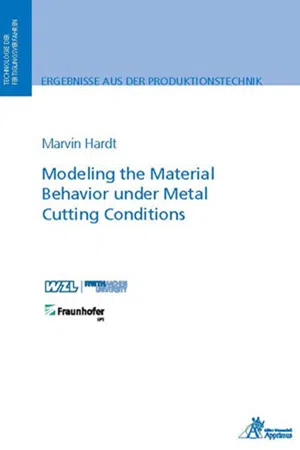
Modeling the Material Behavior under Metal Cutting Conditions
Marvin Hardt
- 202 pages
- English
- PDF
- Available on iOS & Android
Modeling the Material Behavior under Metal Cutting Conditions
Marvin Hardt
About This Book
The scientific goal of the present work was to model the workpiece material behavior of steels in the metal cutting process depending on the occurring thermo-mechanical loads. The results of this work shall make a significant contribution to the predictive process design of the cutting process by means of Finite Element (FE) simulations for the virtual representation of the reality in the sense of the digital twin.To achieve the objective, extensive empirical examinations were conducted in a first step, which included conventional material scientific and orthogonal cutting tests. This enabled the establishment of a database of the workpiece response with increasing thermo-mechanical loads. During the orthogonal cutting examinations, integral and locally resolved process results were measured, which were used as calibration and validation variables in the modeling of the workpiece material behavior.By extending an established friction test bench with a workpiece pre-heating system, the friction conditions between tool and workpiece could be investigated under conditions equivalent to the cutting process. Based on the experimental results, a friction model was derived, in which the observed effects of thermal softening and the localized adhesion-induced increase in the apparent friction coefficient were superposed. A phenomenological material model was developed to describe the workpiece material behavior in the cutting process. The formulation of the material mode was developed based on empirical examinations as well as results from the state of the art. The material model was implemented in an FE-chip formation simulation using a subroutine. A hybrid optimization algorithm was developed to inversely determine the material model parameters. By means of the optimization algorithm, the material model parameters could be systematically determined inversely, taking the experimentally determined process observables into account. An automated procedure linked to a user interface lowered the entry hurdle for industrial companies and unexperienced users of FE-simulations and reduced the computational effort for the inverse parameter determination to about 10 days of computational execution time. The quality of the developed models and the determined model parameters were further verified by a final deduction step using the industrial example of face turning.
Frequently asked questions
Information
Table of contents
- 1 Introduction
- 2 State of the Art
- 3 Objective and Scientific Approach
- 4 Investigations on the Material Behavior of Steels
- 5 Material Model for Cutting Simulations
- 6 Method for the Inverse Parameter Determination
- 7 Validation of the Material Model for Face Turning
- 8 Summary and Outlook
- 9 Appendix
- 10 References
- Résumé